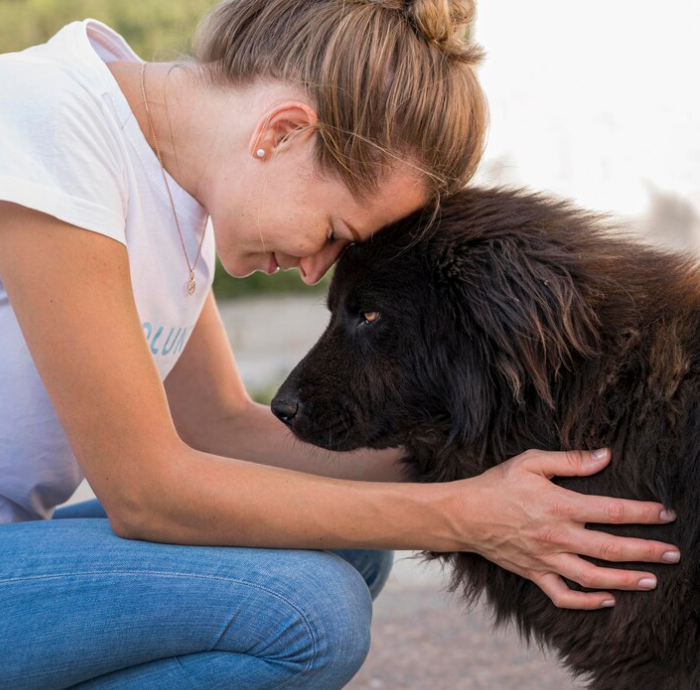
When emotions seem to take over, and we do not know how to deal with them, we tend to rely on our relatives’ and friends’ support. In some cases, they will know how to comfort us and help us put our thoughts and feelings in order; in other cases, this might be more difficult, especially if our emotions are not easy to recognize on the surface. This particularly applies to situations where we feel sad and misunderstood.
While humans do not always possess the set of skills needed to recognize each other’s emotions and respond to them properly, is this also the case with our paw friends? If you feel sad, would your furry friend be able to recognize it?
Let’s talk about our paw family members and how good their skills are in recognizing emotions and sadness, in particular!

Can Dogs Recognize Our Emotions?
Research has confirmed that dogs do recognize human emotions. Canines are known for having mental development in terms of emotions, including intelligence and vocabulary that match the mental development of a toddler.
Even if they might be unable to exactly tell how you feel, they can sense deviations from the standard everyday behavior, including sadness or overexcitement and happiness, and respond to them.
Many dog owners might have already faced situations where their furry friends have chewed their shoes or pieces of furniture; peed at home; broken a valuable item, etc., or otherwise misbehaved. There is a high likelihood for many dogs in this scenario to have changed their expressions and behavior (e.g. giving a guilty glance). Having said that, some dogs can even anticipate their human reactions in a specific situation.
Our beloved paw friends can connect with us on an emotional level and respond to our emotions- they get excited when we are excited or come to us to provide comfort when they sense our sadness.
A study conducted in London has confirmed the great skills dogs have in recognizing sadness in humans. According to it, almost all dogs in the target group went to check on a crying person (either an unfamiliar individual or their owner) and exhibited submissive behavior.

How Do Dogs Recognize Sadness and Other Emotions?
Recognizing Scent
When talking about recognizing emotions, dogs’ great sense of smell might not be the first thing to think of, but it should be!
Throughout many years of evolution, dogs have persevered in their excellent sense of smell, which is still their main tool to navigate their surroundings. It helps them pick up on even the slightest changes in smells, which also applies to the specific scent of the human body.
The scent of a person's body can change in response to emotions like sadness or stress. When an individual experiences these emotions, their body releases different chemicals through sweat and other bodily secretions, which can subtly alter their scent. Research in this area is ongoing, but there is evidence to suggest that emotions can influence body odor. This is particularly valid for situations where we feel overwhelming emotions.
You might be interested in the following studies “Induction of Empathy by the Smell of Anxiety”, and Chemosensory Cues to Conspecific Emotional Stress Activate Amygdala in Humans, published in the National Library of Medicine.
Through their sense of smell, canines can recognize changes in the production of different hormones like serotonin, endorphin, and cortisol. So, in other words- when we feel sad, stressed, overly stimulated, or happy, the levels of some hormones our body produces change. And dogs are great at recognizing these changes!
It is also worth noting that dogs, especially the representatives of some long-muzzled dog breeds like the Poodle, the Border Collie, the Labrador/Golden Retriever, the Bernese Mountain Dog, and the German Shepherd, can become excellent medical alert dogs! Along with the large number of olfactory receptors, a dog should have, of course, the right temperament to become a medical alert dog!
Recognizing Our Body Language
Throughout evaluation for thousands of years, dogs have evolved along with humans, learning to recognize human body language. This applies even to subtle signs such as gestures, posture, and facial expressions.
The stronger the bond between a dog and a human is, the more responsive the dog will be even to the slightest changes in the person’s body language. Natural posture and relaxed body language, along with short and easily remembered verbal cues are both important for dog training to succeed.
Recognizing Your Tone of Voice
In general, dogs use three types of tones to express their feelings and needs:
- High-pitched sounds such as whines and yips to express excitement;
- Mid-pitched sounds to express calmness and relaxation due to a lack of potential threat;
- Low-pitched sounds like growls to show that the dog is warning;
Having said that, dogs recognize our tone of voice. If we are happy with their behavior, we should praise them in an enthusiastic voice to show them how proud we are! Of course, we should not be overly enthusiastic, as we can inadvertently cause them to be hyper or overwhelmed. Also, more sensitive dogs can easily become anxious due to very high-pitched sounds.

How Do Dogs Respond to Our Sadness?
Tactile Stimulation
Some canines are naturally very people-oriented and can respond to emotions even without having formal training. Some owners report being nudged, pawed, or licked by their canines in stressful or sad situations.
Deep Pressure Therapy
In many cases, a dog can even lay on their owner’s chest or put their head/chin on their owner’s lap to calm them down through Deep Pressure Therapy.
Deep Pressure Therapy along with tactile stimulation are the most common techniques for anxiety and stress reduction in Psychiatric Service Dog Training.
Distracting / Redirecting Their Owner’s Attention
Some canines may be eager to distract you from your intrusive thoughts or feelings of sadness. They may encourage you to take them on a walk, pet them, feed them, or provide any type of tactile stimulation to redirect your attention to something else.
Alerting You or Responding to Changes In Your Scent
According to some dog owners, their furry buddies start showing quirky behaviors, i.e. staring at them or whining without an obvious reason. Since some dogs are naturally more sensitive than others, they may want to notify you of an oncoming episode (due to stress, anxiety, or immense sadness).
Another scenario is for a dog to show a specific behavior, like any of those listed above after an episode has already occurred.

Dogs as Psychiatric Service Dogs & Emotional Support Animals
If the feeling of sadness is overwhelming and accompanied by anxiety, symptoms of depression, feeling of being lost, or other signs of a mental health issue, then you might consider training your dog as your psychiatric service dog or emotional support animal.
If your paw friend is calm, affectionate, attuned to you, well-mannered, and picks up on changes in your emotions, then they might have great potential to excel in service dog/companion dog work!
Emotional Support Animals provide comfort and companionship to their owners. They go through basic obedience training and socialization but it is mainly their presence and natural ability to comfort their owner that makes them ESAs. They do not undergo specialized training and do not do specific tasks directly related to a mental health condition. However, consulting a licensed mental health professional and obtaining medical documentation that proves the need for an ESA is needed.
If you need your dog to perform specific tasks for you, which may include tactile stimulation, Deep Pressure Therapy, reminding you to take medication, interrupting repetitive behaviors, retrieving items for you, alerting you to anxiety episodes, etc., then Psychiatric Service Dog Training might be the right fit for you!
As service animals and not pets, Psychiatric Service Dogs are entitled to public access and housing. However, if you decide to embark on this journey, make sure to get familiar with local laws and what criteria PSDs have to meet to be recognized.
While in some countries, such as the US, the UK, many Canadian provinces (British Columbia, Ontario, New Brunswick, etc.), the Netherlands, Brazil, etc., dog owners can train their pet dogs as service dogs, others require certification issued by Assistance Dogs International or the International Guide Dog Federation. There are also countries where dog owners can have their self-trained service dog evaluated by an accredited local trainer/school to be recognized.
As you may have learned from today’s article, dogs can not only sense sadness and recognize our emotions but can do specific tasks to respond to them. They are amazing creatures and deserve all the love and care we can give them!










